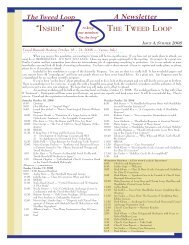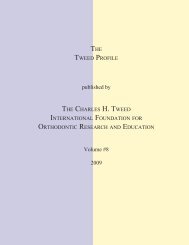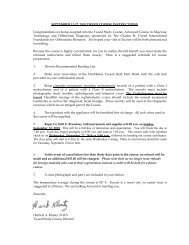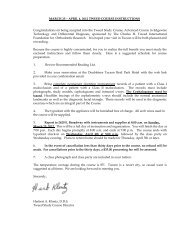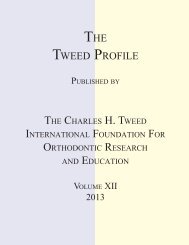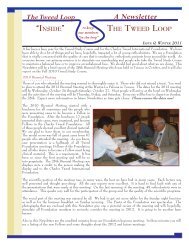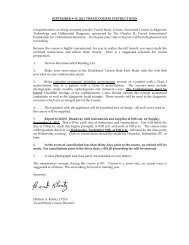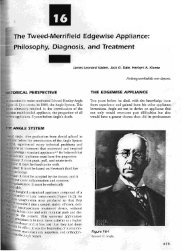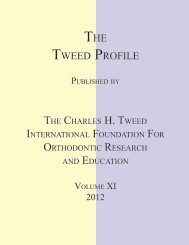© 2006 - The Charles H. Tweed International Foundation
© 2006 - The Charles H. Tweed International Foundation
© 2006 - The Charles H. Tweed International Foundation
You also want an ePaper? Increase the reach of your titles
YUMPU automatically turns print PDFs into web optimized ePapers that Google loves.
Fig. 2. Microimplants: small titaniumminiscrew type (1.2-1.7mmdia.) It has button like head withhole, hexagonal shaft, smoothshaft, and screwFig. 3. Class II Div I case and Class I bimax. case; absolute anchorage; seetremendous retraction of anterior teeth and reduction of ANB, distalmovement of molars.teeth used for anchorage and the number moved are exactly equal. <strong>The</strong> left buccalsegment shows buccal crossbite because of an asymmetrical maxillary arch. <strong>The</strong>microimplant is the choice of treatment (Fig. 6).Molar protraction is one of the most difficult orthodontic movements. In this patient we decided to protract the leftlower 2nd molar to the 1st molar position. We needed very complicated biomechanics for this case even though we usedMI. Finally, a good result was achieved (Fig. 7).One can use intermaxillary elastics (class III or class II elastics) from the MI as shown in this patient. It took only sixmonths for this patient. Class III elastics and MI can be used during the denture preparation stage instead of HPJH (Fig 8).Midline shift is a common problem in orthodontics. Correction of this problem without unfavorable reaction such asocclusal canting is very difficult. This patient shows both the upper and lower midline shifts to the right of the facialmidline. Four first molar extractions were done. We put the microimplant on the left side of the maxilla andtried to shift the maxillary midline to the left used Class III elastics. Class III elastics were simultaneously used toshift the mandibular midline to the left. After treatment, the facial midline and both dental midlines coincided (Fig. 9).Canting of the maxillary occlusal plane is a very difficult problem inorthodontics. <strong>The</strong>re was no solution in the past except surgery. MIprovides a new alternative treatment method. MI was put on the maxillabetween the 1st and 2nd premolars and intrusive force was applied withelastic thread. After intrusion of the maxillary segment, criss crosselastics were placed for uprighting of mandibular premolars. <strong>The</strong> finishedphoto shows a quite good correction of occlusal canting by MIorthodontics (Fig. 10).Fig. 4. Molar uprighting; MI wasinstalled at retromolar area and bondedlingual button on the mesial surface ofthe 2nd molar and applied power chainor elastic thread to upright.Intrusion of incisors: Class II div. 2 patients have a deepbite and lingualtipping of incisors. An MI placed between the central incisors and candeliver intrusive force (around 100gmm) (Fig. 11).Correction of open bite. <strong>The</strong> posterior segment in both arches wasintruded using four MIs. We got good results such as bite closure anddecrease of lower facial height due to intrusion of molars (Fig. 12).IV. <strong>The</strong> installation of microimplants.IV – 1 Installation siteWe routinely install the microimplant for directional force between the 2nd premolar and 1st molar in the maxillaand between the 1st molar and 2nd molar in the mandible. However, any other interdental space or acceptable area38



